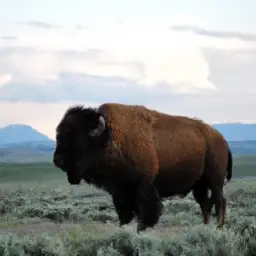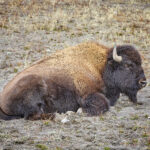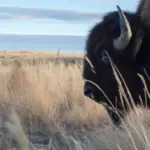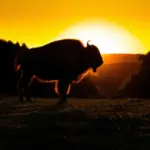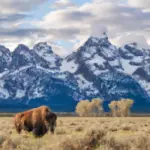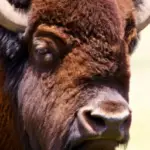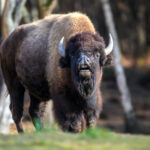Are you a wildlife enthusiast looking for an adventurous experience in Wyoming? Look no further! “Where To See Bison In Wyoming” is the ultimate guide that will take you on an unforgettable journey to witness the awe-inspiring beauty of bison in their natural habitat. Packed with insider tips and detailed information, this product will lead you to the best locations across Wyoming where you can observe these majestic creatures in their element. Prepare to be amazed as you embark on an incredible exploration of bison sightings like never before.
Yellowstone National Park
Overview of Yellowstone National Park
Yellowstone National Park, located in the northwest corner of Wyoming, is a majestic and iconic destination known for its stunning landscapes, geothermal features, and diverse wildlife. Established in 1872 as the first national park in the United States, Yellowstone encompasses over 2.2 million acres of wilderness. Whether you’re an avid nature lover, a wildlife enthusiast, or simply someone seeking adventure, Yellowstone offers a plethora of opportunities to witness the beauty and magnificence of bison in their natural habitat.
Best time to view Bison in Yellowstone
To increase your chances of sighting bison in Yellowstone National Park, it is recommended to visit during the summer and early fall months. These months provide ideal conditions for bison to roam freely and graze on the park’s expansive grasslands. June through September offers the best opportunity to witness the famous bison herds that call Yellowstone home. During this time, the park’s wildlife populations are at their highest, and you can encounter these majestic creatures in various areas, including Hayden Valley, Lamar Valley, and the northern range.
Precautions while viewing Bison in Yellowstone
While observing bison in Yellowstone, it’s important to remember that these are wild animals and should be treated with respect and caution. Bison are known for their size and unpredictable behavior, so it is essential to maintain a safe distance of at least 25 yards. Approaching or attempting to interact with bison can result in dangerous situations and can have severe consequences. Always stay in your vehicle or use designated viewing areas and follow the guidelines provided by park rangers to ensure your safety and the well-being of the bison.
Educational programs about Bison
Yellowstone National Park offers a variety of educational programs and activities to enhance visitors’ understanding of bison and their ecological importance. The park’s visitor centers provide interpretive exhibits, films, and ranger-led talks focused on the biology, history, and conservation efforts related to bison. Joining a guided tour or attending a wildlife education program can deepen your knowledge and appreciation for these magnificent creatures and the role they play in the ecosystem at Yellowstone.
National Elk Refuge
Introduction to National Elk Refuge
Situated just outside the town of Jackson, Wyoming, the National Elk Refuge is a haven for a diverse range of wildlife, including bison. Established in 1912, the refuge spans approximately 24,700 acres and primarily serves as a winter habitat for elk during their migration. However, bison also seek refuge in this area during the colder months, providing visitors with an excellent opportunity to observe these majestic creatures up close.
Opportunities to view Bison at National Elk Refuge
The National Elk Refuge offers unique opportunities to view bison from designated observation points and along the refuge’s scenic drives. During the winter months, when the refuge is blanketed in snow, the bison can often be seen grazing in large herds against the backdrop of the majestic Teton Range. These close encounters with bison provide an intimate and awe-inspiring experience for wildlife enthusiasts and photographers alike.
Safety tips while observing Bison at National Elk Refuge
When observing bison at the National Elk Refuge, it is crucial to respect these powerful animals and maintain a safe distance. Stay within your vehicle or designated viewing areas to avoid any potential risks. Bison can appear docile but are unpredictable, and approaching them can lead to dangerous situations. Always heed the guidelines provided by the refuge’s staff and consider using binoculars or a zoom lens to appreciate the bison from a safe and respectful distance.
Other wildlife sightings at National Elk Refuge
In addition to bison, the National Elk Refuge offers opportunities to witness a diverse range of wildlife species. During the winter months, you may encounter magnificent elk herds, graceful swans, regal trumpeter swans, majestic wolves, and various bird species that inhabit the area. Exploring the refuge’s trails or joining a guided tour can increase your chances of encountering these remarkable creatures in their natural habitat and add to your overall wildlife viewing experience.
Grand Teton National Park
Exploring Grand Teton National Park
Renowned for its towering peaks, pristine lakes, and abundant wildlife, Grand Teton National Park is a paradise for outdoor enthusiasts and wildlife lovers alike. Located in northwestern Wyoming, adjacent to Yellowstone National Park, Grand Teton offers breathtaking vistas and an array of opportunities to witness the natural beauty of bison in their wild habitat.
Hot spots for Bison sightings in Grand Teton National Park
To increase your chances of spotting bison in Grand Teton National Park, certain areas are known for frequent bison sightings. Antelope Flats, near the eastern boundary of the park, is one such hotspot. The vast grasslands of Antelope Flats provide a prime feeding area for bison and offer incredible photographic opportunities. Additionally, the Snake River area and the Gros Ventre River corridor are known to attract bison during different seasons, where they can be observed against the backdrop of the iconic Teton Range.
Rules and guidelines for Bison viewing at Grand Teton National Park
When visiting Grand Teton National Park to observe bison, it is essential to adhere to the rules and guidelines established by the National Park Service. Bison are wild animals and should be observed from a safe distance of at least 100 yards. Approaching or attempting to interact with them can be extremely dangerous and can provoke aggressive behavior. Remember to use binoculars or a telephoto lens to enjoy bison sightings while maintaining a safe distance and respecting their natural behavior.
Buffalo Bill State Park
Understanding Buffalo Bill State Park
Nestled in the scenic Shoshone River Valley near the town of Cody, Buffalo Bill State Park offers a delightful blend of natural beauty and recreational opportunities. With its vast grasslands and proximity to nearby wildlife habitats, it serves as an excellent location to catch a glimpse of bison in their natural element.
How to see Bison at Buffalo Bill State Park
To see bison at Buffalo Bill State Park, visitors can explore the designated viewing areas or hike along the park’s trails, which offer opportunities for wildlife sightings. While bison might not be as frequently spotted in this park as in some other locations, the scenic vistas and tranquil atmosphere make it a worthwhile destination for bison enthusiasts. Consider bringing along a pair of binoculars or a telephoto lens to enhance your chances of spotting bison grazing in the distance.
Activities around Bison viewing at Buffalo Bill State Park
Buffalo Bill State Park not only provides opportunities for bison viewing but also offers a range of recreational activities for visitors to enjoy. Hiking, fishing, boating, and camping are popular pursuits within the park, allowing you to immerse yourself in the natural beauty of the area while keeping an eye out for bison herds and other wildlife. Exploring the park’s diverse ecosystems and engaging in outdoor activities can create a memorable and fulfilling experience for visitors of all ages.
Bison Herds along Wind River
Geography of Wind River
Wind River, located in western Wyoming, offers breathtaking landscapes, rugged mountain ranges, and ample opportunities to experience the splendor of wildlife. This region is known for its vast open spaces, making it an ideal habitat for bison herds to roam freely.
Bison movement around Wind River
Bison herds in the Wind River region tend to move within their established territories, seeking out the most favorable foraging areas and water sources. They often migrate in response to seasonal changes and availability of food. The expansive grasslands, river valleys, and foothills along Wind River provide suitable conditions for these magnificent animals to thrive and continue their natural movements.
Safely approaching Bison at Wind River
When encountering bison along Wind River, it is crucial to exercise caution and respect for their space. Stay at a safe distance and avoid any sudden movements or actions that might startle the bison. It is essential to remember that bison are wild animals and can be unpredictable. Observing them from a distance and using binoculars or cameras with zoom lenses will allow you to appreciate their presence while ensuring both your safety and the well-being of the bison.
Bison Watching at Wyoming State Parks
Visiting Wyoming State Parks
Wyoming State Parks offer not only breathtaking natural beauty but also excellent opportunities for bison watching. With numerous state parks spread across the state, visitors can explore different regions and view a variety of wildlife, including bison in their natural habitat.
State Parks known for Bison
Several Wyoming State Parks are renowned for their resident bison herds. Curt Gowdy State Park, located near the city of Cheyenne, provides glimpses of bison grazing on its expansive prairies. Additionally, Hot Springs State Park, nestled in Thermopolis, offers unique thermal features along with sightings of bison within its boundaries. Both parks offer a combination of recreational activities, scenic landscapes, and wildlife viewing, making them popular choices for bison enthusiasts.
Tips and tricks for Bison watching at State Parks
When visiting Wyoming State Parks for bison watching, remember to maintain a safe distance and follow the guidelines provided by park staff. Binoculars or a telephoto lens will allow you to observe the bison from a distance without disturbing their natural behavior. Consider visiting during the early morning or late evening, as these times often offer better opportunities to spot bison in action. Also, be sure to respect the park’s rules and regulations, stay on designated trails, and leave no trace to preserve the natural integrity of these parks.
The Science Zone’s Bison Exhibit
Uncovering The Science Zone
The Science Zone, located in Casper, Wyoming, is a hands-on science center that offers engaging educational experiences for visitors of all ages. One of the highlights of The Science Zone is its Bison Exhibit, which provides a unique opportunity to learn about bison ecology, behavior, and conservation efforts.
Exploring Bison Exhibit at The Science Zone
The Bison Exhibit at The Science Zone allows visitors to discover the fascinating world of bison through interactive displays, informative exhibits, and engaging activities. Learn about the historical significance of bison in the American West, their ecological role, and the challenges they face in modern times. Interactive elements, such as simulated bison tracking or exploring a bison habitat replica, offer a hands-on learning experience that is both educational and entertaining.
Engaging in interactive learning at The Science Zone’s Bison Exhibit
The Science Zone’s Bison Exhibit not only provides an in-depth understanding of bison but also fosters a sense of wonder and curiosity among visitors. Engage in interactive learning experiences, such as hands-on experiments or guided tours led by knowledgeable staff, to deepen your understanding of bison biology and conservation. Whether you’re a student, a family, or a curious individual, The Science Zone’s Bison Exhibit offers a unique opportunity to connect with these magnificent animals and broaden your knowledge of their importance in our ecosystem.
Winter Wildlife Viewing in Wyoming
Bison during winter in Wyoming
Winter in Wyoming presents a unique opportunity to witness the raw beauty of wildlife, including bison, against the backdrop of snowy landscapes. During the colder months, bison often congregate in lower elevations where food sources are more accessible, such as valleys and plains. This behavior increases the chances of sighting these magnificent creatures as they navigate through the winter terrain.
Best locations for winter Bison viewing
To optimize your chances of seeing bison during winter in Wyoming, several locations are known for their reliable wintering grounds. The National Elk Refuge near Jackson provides excellent opportunities to observe bison and other wildlife during the winter months. Additionally, both Yellowstone National Park and Grand Teton National Park offer unforgettable winter wildlife experiences, with bison frequently spotted in various areas within the parks. Proper preparation, including warm clothing, snowshoes, and knowledge of winter travel safety, is essential when venturing out for winter bison viewing.
Protecting yourself and the Bison during winter
It is vital to prioritize your safety and the well-being of bison when viewing them during winter. Keep a safe distance, preferably from the comfort of your vehicle or designated viewing areas, to avoid disturbing the animals or inadvertently placing yourself in harm’s way. The harsh winter conditions can make bison more defensive, so it is crucial to respect their natural behavior and avoid any actions that might agitate them. By practicing responsible wildlife viewing and following park regulations, you can enjoy the winter spectacle while ensuring the safety and preservation of both yourself and the bison.
Guided Bison Tours in Wyoming
Choosing a Bison tour in Wyoming
For those seeking a more immersive and educational experience, guided bison tours in Wyoming offer a fantastic opportunity to delve deeper into the world of these magnificent creatures. There are various tour companies and organizations that provide expert-led excursions, sharing their knowledge while ensuring the safety and comfort of participants.
What to expect during a Bison tour
During a guided bison tour, you can expect to embark on an exciting adventure that takes you into the heart of bison country. Experienced guides will share insights into bison ecology, behavior, and conservation efforts, enriching your understanding and appreciation of these majestic animals. You may have the opportunity to observe bison herds from a safe distance, learn tracking techniques, and even glimpse rare sightings. Each tour is unique, offering its own blend of education and adventure, ensuring a memorable and informative experience for enthusiasts of all ages.
Benefits of guided Bison Tours
Guided bison tours provide several benefits that enhance your wildlife viewing experience. Professional guides possess extensive knowledge about bison and their habitat, allowing you to gain insights and learn fascinating facts that you might otherwise miss. These tours often provide access to restricted areas and private lands, providing exclusive opportunities to observe bison in less-traveled locales. Moreover, by participating in guided tours, you support local tour operators and conservation initiatives, contributing to the ongoing preservation of bison and their ecosystem.
What Are the Best Locations to Spot Bison in Wyoming?
If you’re interested in seeing bison in Colorado, Wyoming is also a great place to spot these majestic creatures. Yellowstone National Park and Grand Teton National Park are two of the best locations to see bison in their natural habitat. Wildlife enthusiasts flock to these areas for the chance to witness these impressive animals up close.
Bison Conservation in Wyoming
Current Bison conservation efforts in Wyoming
Wyoming plays a significant role in bison conservation, with various organizations and initiatives dedicated to preserving these iconic animals. Collaborative efforts between federal, state, and tribal entities strive to protect and restore bison populations, manage their habitats sustainably, and promote genetic diversity through strategic breeding programs. Bison conservation initiatives in Wyoming focus on maintaining healthy herds, preserving their ecological integrity, and promoting public awareness about the importance of bison in our natural landscapes.
How tourists can contribute to Bison conservation
As a tourist, there are several ways you can contribute to bison conservation efforts in Wyoming. Supporting local conservation organizations and initiatives through donations or volunteer work can make a significant impact. Respecting wildlife and their habitats, including adhering to park regulations and guidelines, minimizes disturbance to bison populations and helps protect their natural behavior. Additionally, learning about bison ecology and sharing your knowledge with others promotes awareness and appreciation, ensuring the long-term survival of these magnificent creatures.
Learning about Bison ecology and behavior in Wyoming
One of the most effective ways to contribute to bison conservation is to educate yourself about their ecology and behavior. By learning about bison’s critical role in ecosystem dynamics, their historical significance, and the challenges they face today, you can become a knowledgeable advocate for their protection. Utilize the resources available, such as visitor centers, museums, and educational programs in Wyoming, to deepen your understanding of bison ecology and behavior. Sharing this knowledge with others can help inspire a collective effort to ensure the preservation and thriving of bison populations for generations to come.
In summary, Wyoming offers numerous opportunities for bison enthusiasts and wildlife lovers to witness the magnificence of these iconic animals. Whether visiting Yellowstone National Park, observing bison at the National Elk Refuge, exploring Grand Teton National Park, or engaging in other bison-watching adventures throughout the state, there is an abundance of options to experience the beauty and significance of bison in their natural habitat. By following safety guidelines, respecting wildlife, and supporting conservation efforts, you can contribute to the protection and preservation of these remarkable creatures for future generations to enjoy.

